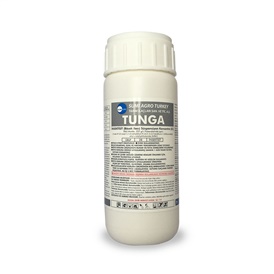

Category: PLANT PROTECTION
Type: INSECTICIDE
Translaminar is a new generation insecticide that is immediate and long lasting.
Active substance: Contains 222 g / L Flubendiamide.
Group 28
SC: (suspension concentrate)
It is very effective in many Lepidoptera species, including tomato moth (Tuta absoluta).
The pest is effective against all larval stages and provides excellent activity and long-term protection.
It has a double action mechanism including digestion and contact.
Feeding of the pest ceases very quickly after spraying and rapid deaths begin, resulting in minimal damage to plants.
It is a new alternative to harmful resistance management thanks to the new mechanism of action. It is not cross-resistant with other Lepidoptera control insecticides.
It has long lasting effect.
Repetitive applications of plant protection products with the same mechanism of action promote resistance development. Therefore, in order to delay the development of resistance, do not exceed the recommended number of applications of the plant protection product during the same production season. In cases where the application should be repeated, pay attention to the use of plant protection products with different mechanism of action.
Usage
Preparation of the drug for administration:
Before use, the bottle should be shaken thoroughly. The required amount of the drug is mixed first with a little water in a separate container. The sprayer is filled with water up to half and the mixture is poured into it and the remaining amount of water is added and mixed. Since the systemic effect of the drug is low, care should be taken to apply a good coating.
- Application should be done after morning dew and in the cool hours of the day.
- In order to ensure contact with the pest, it is necessary to spray the medicament, including the lower surfaces of the leaves, in a good coating.
Greenworm in cotton: Controls are started during the carding period. An area of 50 decares is considered 1 unit and divided into 3 parts. Egg and larvae are counted by checking all plants during each 3-meter plant in each section. 2 larvae / 3 meters is decided to apply.
Cluster moth in the vineyard: Cluster moth spraying times are determined according to the Forecast Alert system. For larvic application, the number of butterflies caught in the traps should reach the peak and begin to fall, the effective temperature total should be 120 g.d. in the first offspring, twilight temperatures should be 15ºC and above for 2 consecutive days, and this should continue in the following days. The effective temperature should reach 520 g.d. in the second offspring, 1047 g.d. in the third offspring. When the first larval exit is seen, it is decided to apply. Each offspring is made one spraying.
Tomato moth in tomato (sera): According to the size of the production area, at least 100 plants are controlled and eggs and larvae are sought in the plant's flowers, leaves and shoots. If 3 of 100 plants are infected with larvae and eggs, disinfection is done.
Cotton leaves in cucumbers: In 100 plants chosen randomly in diagonal lines, 1-2 freshly opened egg packages or 4-5 larvae start to fight. The survey is repeated in the same field at intervals of 10-12 days. If above the threshold, the spraying is repeated. Spraying is more successful if the larvae are done without dispersing.
Greenworm in pepper: Eggs and larvae are sought in the flowers, leaves, stalks, fruits and shoots of 100 plants randomly selected in the diagonal direction. If 5 out of 100 plants are contaminated, the fight is started immediately.
Sosyal Ağ